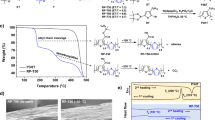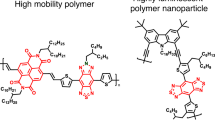Abstract
Conducting organic polymers have found two main kinds of application in electronics so far: as materials for construction of various devices and as selective layers in chemical sensors. In either case, interaction with ambient gases is critical. It may compromise the performance of a device based on conducting polymers, whereas it is beneficial in a sensor. Conductivity has been the primary property of interest. Work function — related to conductivity, but in principle a different property — has received only scant attention. Our aim here is to discuss the usability of conducting polymers in both types of electronic applications in light of these two parameters.
This is a preview of subscription content, access via your institution
Access options
Subscribe to this journal
Receive 12 print issues and online access
$259.00 per year
only $21.58 per issue
Buy this article
- Purchase on Springer Link
- Instant access to full article PDF
Prices may be subject to local taxes which are calculated during checkout





Similar content being viewed by others
References
McQuade, D.T., Pullen, A.E. & Swager, T.M. Conjugated polymer-based chemical sensors. Chem. Rev. 100, 2537–2574 (2000).
Gerard, M., Chaubey, A. & Malhotra, B.D. Application of conducting polymers to biosensors. Biosens. Bioelectron. 17, 345–359 (2002).
Dimitrakopoulos, Ch. D. & Malenfant, P.R.L. Organic thin film transistors for large area electronics. Adv. Mater. 14, 99–117 (2002).
Dimitrakopoulos, C.D. & Mascaro, D.J. Organic thin-film transistors: a review of recent advances. IBM J. Res. Dev. 45, 11–27 (2001).
Angelopoulos, M. Conducting polymers in microelectronics. IBM J. Res. Dev. 45, 57–75 (2001).
Gazotti, W.A. et al. Handbook of Advanced Electronic and Photonic Materials and Devices Vol. 10 (ed. Nalva, H.S.) 53–98 (Academic, New York, 2001).
Otero, T.F. in Polymer Sensors and Actuators (eds Osada, Y. & De Rossi, D.E.) 295–324 (Springer, Berlin, 2000).
Bailey, R.A. & Persaud, K.C. in Polymer Sensors and Actuators (eds Osada, Y. & De Rossi, D.E.) 149–181 (Springer, Berlin, 2000).
Huber, R.J. in Solid State Chemical Sensors (eds Janata., J. & Huber, R.J.) 119–162 (Academic, New York, 1985).
Leclerc, M. Optical and electrochemical transducers based on functionalized conjugated polymers. Adv. Mater. 11, 1491–1498 (1999).
Milella, E. & Penza, M. SAW gas detection using Langmuir–Blodgett polypyrrole films. Thin Solid Films 329, 694–697 (1998).
Hwang, B.J., Yang, J.Y. & Lin, C.W. Recognition of alcohol vapor molecules by simultaneous measurements of resistance changes on polypyrrole-based composite thin films and mass changes on piezoelectric crystal. Sens. Actuat. B 75, 67–75 (2001).
Michalska, A. & Lewenstam, A. Potentiometric selectivity of p-doped polymer films. Anal. Chim. Acta 406, 159–169 (2000).
Albert, K.J. et al. Cross-reactive chemical sensor arrays. Chem. Rev. 100, 2595–2626 (2000).
Epstein, A.J. & Mele, E.J. (eds) Symposium proceedings 4–5 May 2000. Synth. Met. 125, 138 (2001).
Heeger, A.J. Semiconducting and metallic polymers: the fourth generation of polymeric materials (Nobel lecture). Angew. Chem. Int. Edn 40, 2591–2611 (2001).
Nalwa, H.S. (ed.) Handbook of Organic Conductive Molecules and Polymers (Wiley, New York, 1997).
Leuninger, J. et al. Poly(phenylene sulfide-phenyleneamine) (PPSA): The first hybrid structure of poly(phenylene sulfide) and polyaniline. Macromol. 31, 1720–1727 (1998).
Pron, A. & Rannou, P. Processible conjugated polymers: from organic semiconductors to organic metals and superconductors. Prog. Polym. Sci. 27, 135–190 (2002).
Cabala, R., Meister, V. & Potje-Kamloth, K. Effect of composite doping on sensing properties of polypyrrole. J. Chem. Soc. Faraday Trans. 93, 131–137 (1997).
MacDiarmid, A.G. & Epstein, A.J. Secondary doping in polyaniline. Synth. Met. 69, 85–92 (1995).
Domansky, K., Li, J. & Janata, J. Selective doping of chemically sensitive layers on a multisensing chip. J. Electrochem. Soc. 144, 75–78 (1997).
Josowicz, M., Li, H.S., Domansky, K. & Baer, D. Effect of palladium in polyaniline layers on selectivity to hydrogen. Electroanal. 11, 774–781 (1999).
Li, J., Petelenz, D. & Janata, J. Suspended gate field-effect transistor sensitive to gaseous hydrogen cyanide. Electroanal. 5, 791–794 (1993).
Hernandez-Perez, T., Morales, M., Batina, N. & Salmon, M. Effect of the electrosynthesis method on the surface morphology of the polypyrrole film an atomic force microscopy study. J. Electrochem. Soc. 148, 369–375 (2001).
Patil, S., Mahajan, J.R., More, M.A. & Patil, P.P. Electrochemical synthesis of poly(o-methoxyaniline) thin films: effect of post treatment. Mater. Chem. Phys. 58, 31–36 (1999).
Janata, J. Electrochemical sensors and their impedances: A tutorial. Crit. Rev. Anal. Chem. 32, 109–120 (2002).
Zheng, W. et al. Effect of organic vapors on the molecular conformation of non-doped polyaniline. Synth. Met. 84, 63–64 (1997).
Leising, G., Tasch, S. & Graupner, W. in Handbook of Conducting Polymers 2nd edn (eds Skotheim, T.A. Elsenbaumer, R.L. & Reynolds, J.R.) 854 (Marcel Dekker, New york, 1998).
Barsan, N. & Weimar, U. Conduction model of metal oxide gas sensors. J. Electroceram. 7, 143–167 (2001).
Stussi, E., Stella, R. & De Rossi, D. Chemoresistive conducting polymer-based odour sensors: influence of thickness changes on their sensing properties. Sens. Actuat. B 43, 180–185 (1997).
Li, G., Josowicz, M. & Janata, J. Electrochemical assembly of conducting polymer films on an insulating surface. Electrochem. Solid State 5, 5–8 (2002).
Domansky, K., Leng, Y., Williams, C.C., Janata, J. & Petelenz, D. Appl. Phys. Lett. 63, 1513–1515 (1993).
Wang, P.C., Huang, Z. & MacDiarmid, A.G. Critical dependency of the conductivity of polypyrrole and polyaniline films on the hydrophobicity/ hydrophilicity of the substrate surface. Synth. Met. 101, 852–853 (1999).
Ogura, K., Tonosaki, T. & Shiigi, H. AC Impedance spectroscopy of a humidity sensor using poly(o-phenylenediamine)/poly(vinyl alcohol) composite film. J. Electrochem. Soc. 148, 21–27 (2001).
Musio, F., Amrani, M.E.H. & Persaud, K.C.D. High-frequency AC investigation of conducting polymer gas sensors. Sens. Actuat. B 23, 223–226 (1995).
Ingleby, P., Gardner, J.W. & Bartlett, P.N. Effect of micro-electrode geometry on response of thin-film poly(pyrrole) and poly(aniline) chemoresistive sensors. Sens. Actuat. B 57, 17–27 (1999).
Casalini, R., Wilde, J.N., Nagel, J., Oertel, U. & Petty, M.C. Organic vapour sensing using thin films of a co-ordination polymer: comparison of electrical and optical techniques. Sens. Actuat. B 57, 28–34 (1999).
Josowicz, M. & Janata, J. Suspended gate field-effect transistor modified with polypyrrole as alcohol sensor. Anal. Chem. 58, 514–517 (1986).
Mulliken, R.S. New electroaffinity scale; together with data on valence states and on valence ionization potentials and electron affinities. J. Chem. Phys. 2, 782–93 (1934).
Janata, J. & Josowicz, M. A fresh look at some old principles: The Kelvin probe and the Nernst equation. Anal. Chem. 69, 293–296 (1997).
Janata, J. & Josowicz, M. Chemical modulation of work function as a transduction mechanism for chemical sensors. Acc. Chem. Res. 31, 241–248 (1998).
Janata, J. Chemical modulation of the electron work function. Anal. Chem. 63, 2546–2550 (1991).
Blackwood, D. & Josowicz, M. Work function and spectroscopic studies of interactions between conducting polymers and organic vapors. J. Phys. Chem. 95, 493–502 (1991).
Topart, P. & Josowicz, M. Characterization of the interaction between poly(pyrrole) films and methanol vapor. J. Phys.Chem. 96, 7824–7830 (1992); ibid Transient effects in the interaction between poly(pyrrole) and methanol vapor. 8662–8666.
Potje-Kamloth, K. Chemical gas sensors based on organic semiconductor polypyrrole. Crit. Rev. Anal. Chem. 32, 121–140 (2002).
MacDiarmid, A. Polyaniline and polypyrrole: where are we headed? Synth. Met. 84, 27–34 (1997).
Hatchett, D.W, Josowicz, M. & Janata, J. Acid doping of polyaniline: spectroscopic and electrochemical studies. J. Phys. Chem. B. 103, 10992–10998 (1999).
Li, G., Josowicz, M. & Janata, J. Electrochemical modulation of the electronic properties in conducting poly(phenylenesulfidephenyleneamine). Synth. Met. 125, 273–278 (2001).
Potje-Kamloth, K, Polk, B.J., Josowicz, M. & Janata, J. Doping of polyaniline in solid-state with photogenerated triflic acid. Chem. Mater. 14, 2782–2787 (2002).
Josowicz, M. & Janata, J. in Chemical Sensor Technology (ed. Seiyama, T.) 153–177 (Elsevier, New York, 1988).
Gaponik, N.P., Shchukin, D.G., Kulak, A.I. & Sviridov, D.V. A polyaniline-based microelectrochemical transistor with an electrocatalytic gate. Mendeleev Commun. 7, 70–71 (1997).
Covington, J.A., Gardner, J.W., Briand, D. & de Rooij, N.F. A polymer gate FET sensor array for detecting organic vapours. Sens. Actuat. B77, 155–162 (2001).
Janata, J. Principles of Chemical Sensors 81–168 (Plenum, New York, 1989).
Polk, B.J., Potje-Kamloth, K., Josowicz, M. & Janata, J. Role of protonic and charge transfer doping in solid-state polyaniline. J. Phys. Chem. 106, 11457–11462 (2002).
Polk, B.J., Smith, A.J., DeWeerth, S.P, Zhou, Z., Janata, J. & Domansky, K. Design of solid state array for simultaneous potentiometric and impedance sensing in gas phase. Electroanal. 11, 707–711 (1999).
Sundgren, H., Lundstroem, I. & Vollmer, H. Chemical sensor arrays and abductive networks. Sens. Actuat. B 9, 127–131 (1992).
Potje-Kamloth, K. in Handbook of Surfaces and Interfaces of Materials Vol. 5 (ed. Nalwa, H.S.) 445–494 (Academic, San Diego, 2001).
Acknowledgements
This work was supported by the National Science Foundation, grant no. CHE-9816017.
Author information
Authors and Affiliations
Corresponding author
Ethics declarations
Competing interests
The authors declare no competing financial interests.
Rights and permissions
About this article
Cite this article
Janata, J., Josowicz, M. Conducting polymers in electronic chemical sensors. Nature Mater 2, 19–24 (2003). https://doi.org/10.1038/nmat768
Issue Date:
DOI: https://doi.org/10.1038/nmat768
This article is cited by
-
C-C coupling of polymer chains in thin films of oxidized polypyrrole doped by BF4− and PF6− anions: Quantum chemical modeling
Journal of Solid State Electrochemistry (2024)
-
Chemiresistive sensing with functionalized carbon nanotubes
Nature Reviews Methods Primers (2023)
-
An in situ synthesis of polyaniline/reduced graphene oxide nanocomposite flexible thin film on PET for the room temperature detection of trace level ammonia at ppb level
Journal of Materials Science (2023)
-
Solution-processed wafer-scale nanoassembly of conducting polymers enables selective ultratrace nerve agent detection at low power
Nano Research (2023)
-
Effect of TX-100 pretreatment on carbon paste electrode for selective sensing of dopamine in presence of paracetamol
Scientific Reports (2022)



